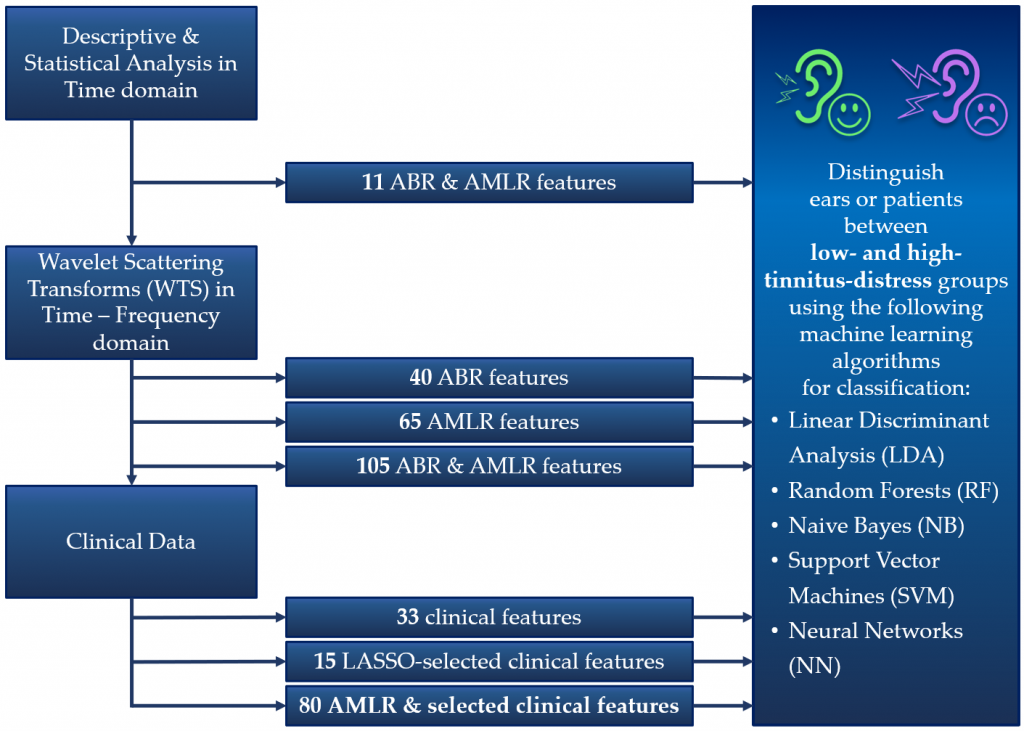PhD thesis defense to be held on April 5, 2023, at 12:00 (Multimedia/Tele-teaching room, NTUA Central Library Building)

Figure: Overall Study Workflow
Picture Credit: Ourania Manta
Thesis title: Development of Intelligent Machine Learning Models Using Multidimensional Data for the Evaluation and Classification of Chronic Tinnitus Patients
Abstract: Tinnitus consists of the perception of a phantom sound, including the patient's reaction to it. Tinnitus is particularly prevalent, with more than 1 in 7 adults in the European Union (EU) suffering from it, and has a negative impact on the quality of life for many people. There is currently no cure for tinnitus, and its pathophysiology and genesis are unknown. Auditory evoked potentials (AEPs) provide a non-invasive means by which electrical signals evoked by the brain can be recorded and constitute a useful indicator for the assessment of auditory disorders such as tinnitus and hearing loss. The current PhD thesis aims to assess the potential contribution of early and middle auditory AEPs in determining the profile of patients with subjective tinnitus, depending on the discomfort and degree of disability caused by the symptom. Considering the aforementioned data, this PhD thesis presents the development of models based on artificial intelligence to classify tinnitus sufferers according to their level of distress. All data were collected within the European research project UNITI (Unification of treatments and Interventions for Tinnitus patients) and derived from chronic subjective tinnitus patients from three different clinical centres in the EU. Model input features were mostly derived from the auditory brainstem response (ABR) and auditory middle latency response (AMLR) waveforms, and secondarily from other selected clinical data from the project. Regarding the waveforms, two automated annotation tools were initially developed and presented in detail, the application of which led to the identification of the waveforms' waves of interest and thus to the direct calculation of their core metrics. Subsequently, the feature extraction and feature selection steps included, among others, statistical analyses, advanced wavelet scattering transform (WST) methods, and the least absolute shrinkage and selection operator (LASSO) regression method. Several models were developed and tested on different datasets to meet the classification requirements more comprehensively. Seven well-known classifiers were used on all generated datasets: random forests (RF), radial, linear, and polynomial support vector machines (SVM) classifiers, naïve Bayes (NB), neural networks (NN), and linear discriminant analysis (LDA). A 10-fold cross-validation was used to evaluate all models. The analyses' findings highlighted wavelet scattering transform-based AMLR signal features as the most informative data of the studied classification. The latter features, in combination with the 15 clinical features selected by the LASSO method and the radial SVM classifier, achieved the highest values in the AUC (area under the curve) (93.08%), sensitivity (84.84%), and specificity (83.04%) measures.
Supervisor: Professor Emeritus Dimitrios Koutsouris
PhD Student: Ourania Manta
